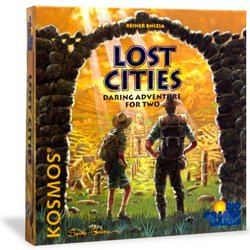Lost Cities board game
by Tom
(Salem, MA, USA)


Game:
Lost Cities
Board game manufacturer:
Kosmos
Number of players:
2
Quick verdict
Lost Cities
is a relatively simple card-matching game with a nice concept. It plays out with a good mixture of strategy and luck. Games can be a little samey, but overall it’s a lot of fun. There’s a board and 60 cards with attractive production values.
The game and gameplay
The scenario is that players are planning expeditions to five exotic destinations. The progress of an expedition is indicated by cards laid down in sequence. The further along an expedition proceeds, the greater the reward. However, if an expedition is started but goes nowhere, you may lose points.
 Included in the box are a wide board, which folds into three, and five sets of 12 destination cards. The board is designed like a desk laid out with plans for the five destinations, each one represented by a crumpled map or parchment.
Included in the box are a wide board, which folds into three, and five sets of 12 destination cards. The board is designed like a desk laid out with plans for the five destinations, each one represented by a crumpled map or parchment.
Each set of destination cards consists of three “investments” cards and nine “expedition” cards with values from 2 through 10.
The five destinations are: Himalayan (White), Rain Forest (Green), Egypt (Yellow), Volcano (Red) and Undersea (Blue). The artwork on the board and the cards is simple, but attractive.All destination cards are shuffled together and each player is dealt eight cards. The rest of the cards constitute a draw pile. Players alternate turns in which they must play one card onto the board and draw one card to replace it. The game ends when the last card is drawn from the draw pile.
When playing a card, there are two options. You can either add a card to an expedition, or discard a card.
When building an expedition, cards must be added in sequence. An expedition can start with up to three “investment” cards. After that, expedition cards must be added in ascending order – it doesn’t have to be strictly sequential, but each card added must have a larger value than the previous one. The cards are laid down in front of the appropriate destination map on the player’s side of the board.
When you discard a card, it’s placed face up onto the destination map graphic on the board. When drawing a card, you can either take the top card from the draw pile or the top card from any of the discard piles.
 Scores are added up at the end of the game. The score for each expedition started by each player is calculated separately and then summed to get the player’s total score. Each expedition started begins with a score of minus 20, to represent the initial cost.
Scores are added up at the end of the game. The score for each expedition started by each player is calculated separately and then summed to get the player’s total score. Each expedition started begins with a score of minus 20, to represent the initial cost.
To this, the sum total of the number cards played is added. A multiplier is then applied depending on the number of investment cards – 2, 3, or 4 for one, two or three investment cards respectively. The possible scores for an expedition vary from minus 80 (three investment cards and no numbered cards) to 156 (three investment cards and all numbered cards from 2 through 10).
If you spread yourself too thin trying to mount too many expeditions, then you run the risk of losing points. However, if you wait too long to mount an expedition, you may lose the chance.
Games are played in sets of three or five.
Pros and cons
Each game plays out fairly quickly, so there’s always a chance to bounce back quickly from a loss. There’s an interesting mixture of strategy and luck. The strategy to focus on two or three destinations is obvious, but the choice of which to aim for is difficult. You may find that the cards just aren’t there for an expedition to which you have committed.
Even with the flavor provided by the concept, the gameplay is pretty simple and games can often play out in a similar fashion. Frustration can set in if you have a run of bad luck and negative scores. Have plenty of scrap paper on hand to do the math after each game.
The verdict
Lost Cities
promises “Daring adventure for two.” What it delivers is a fun, quick to learn and fast-playing card matching game with a fun concept. My wife and I have a number of two-player games and this is by far the one we play the most.

Comments for Lost Cities board game Average Rating | ||
| ||
| ||